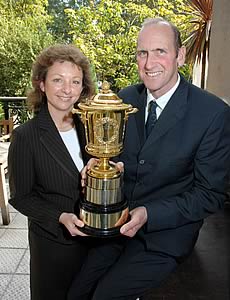 |
|||||||||
|
|||||||||||||||||||
|
|
Third
Time Lucky as Lancashire Jersey Herd Strikes Gold Finalists for the past three years, Ian and Sally Macalpine from Clitheroe, in Lancashire, have risen to the top spot this year and won the UK dairy industry’s most prestigious award – the NMR/RABDF Gold Cup. A finalist for the second year running Peter Jack from Blandford Forum, in Dorset, is this year’s runner-up and wins the NMR Silver Salver.
Ian and Sally Macalpine run the 200-cow pedigree Ribblesdale herd at Laneside Farm, Waddington, near Clitheroe. They restocked their 68-hectare grass farm with Jersey cows, switching from Holsteins, five years ago after the FMD outbreak in 2001. The move to Jerseys was driven by Ian Macalpine’s determination to produce a value- added milk rather than continue to sell milk into a commodity market. Five years on, production has exceeded the Macalpine’s expectations. NMR yield averages are 6,200kg per cow at 6% butterfat and 4% protein. Cell counts are running at 165,000/ml and herd longevity is high with 30% of cows in at least their fifth lactation. Helping the Macalpines achieve high performance is herdsman Les Helliwell and apprentice Sam Wearden, as well as occasional part-time staff. Making the best use of available land is important to the Macalpine’s business and the Jersey breed fits in well. “Jerseys are very efficient producers of milk solids out of dry matter,” says Ian Macalpine. “They can be up to 30% more efficient than a Holstein cow. We can keep 200 Jersey milkers where we could only have 150 black and whites.” Since the outset, when a herd of Danish imported cows was purchased in the UK, milk has been supplied to J and E Dickinson’s Longley Farm Dairy at Holmfirth, near Huddersfield, where the price is based on butterfat and protein content. A review of the herd’s diet last year led to the introduction of a more energy dense TMR based on grass silage, molasses, grain beet, concentrate and some fat, and fed at a flat rate all year round. In just six months the new diet increased herd margins by 23% with no increase in cow numbers. All herd replacements are home bred by Danish and American sires
with the intention of building herd numbers up to a maximum of
220 with an average yield of 6,500kg. Ian and Sally Macalpine also won the Lilyhill Cup for the third year running, awarded to the highest placed Jersey herd in the Gold Cup competition. Runner-up – Peter Jack Peter Jack farms in partnership with his wife Margaret at Normandy Farm, Winterborne Stickland, near Blandford Forum, which forms part of the Crown Estate. His 155-cow pedigree herd averaged 11,854kg of milk at 3.84% butterfat and 3.04% on twice-a-day milking. The SCC stood at 128,000cells/ml, with a calving interval of 435 days and a replacement rate of 15%. Heifers are 28 months of age when they calve. Milk from Peter’s herd is sold on a Waitrose contract. Peter takes a commercial approach to breeding and hasn’t bred for milk yield for five years. He is looking for functional cows – a balance of type and production – and size is important too. Peter likes a large cow with plenty of capacity for forage. Milk from forage currently stands at 2,987 litres. The herd calves all year round and is fed a TMR. High yielders are ‘topped up’ using out-of-parlour feeders and concentrates are also fed in the parlour. The herd’s margin over feed is 15.95ppl. Expansion – as part of a 10-year plan – is on-going with cow numbers expected to reach 200 by December. “This expansion has been made possible thanks to our dedicated and high skilled and motivated staff,” says Peter, who adds that, next to his wife, his staff are the most valuable asset on the unit. Peter also values and takes pride in the farm’s environment and believes it is possible for a high-output, large-scale system to be managed in harmony with the surrounding landscape and wildlife. The chairman of the competition judges, dairy farmer and RABDF chairman Lyndon Edwards, commented on the extremely high level of stockmanship on all farms. “But what added to this in the case of the Macalpines was the market focus. They turned FMD into an opportunity,” says Mr Edwards. “They considered what the market required before restocking. This showed great vision and ambition.” Commenting on behalf of the judges, Mr Edwards also drew attention to the Jack’s thorough five-year plan and the team work in evidence in the operation of the unit. “They made good improvements on last year, particularly in the quality of stock and the attention to business detail.” More than 800 dairy herds were eligible to enter this year’s NMR/RABDF Gold Cup. The six finalists were selected from all completed entries for their comprehensive business approach and outlook for the future. Joining Lyndon Edwards on the judging panel were dairy farmer and NMR board member Trevor Lloyd and Dr Malcolm Crabtree of Leckford Estates.
|
||||||||||||||||||

|
|
||||||||||||||||||
| home | agri-services | pedigree
pen | news | dairy | beef | machinery property | organisations | site map |
|||||||||||||||||||


